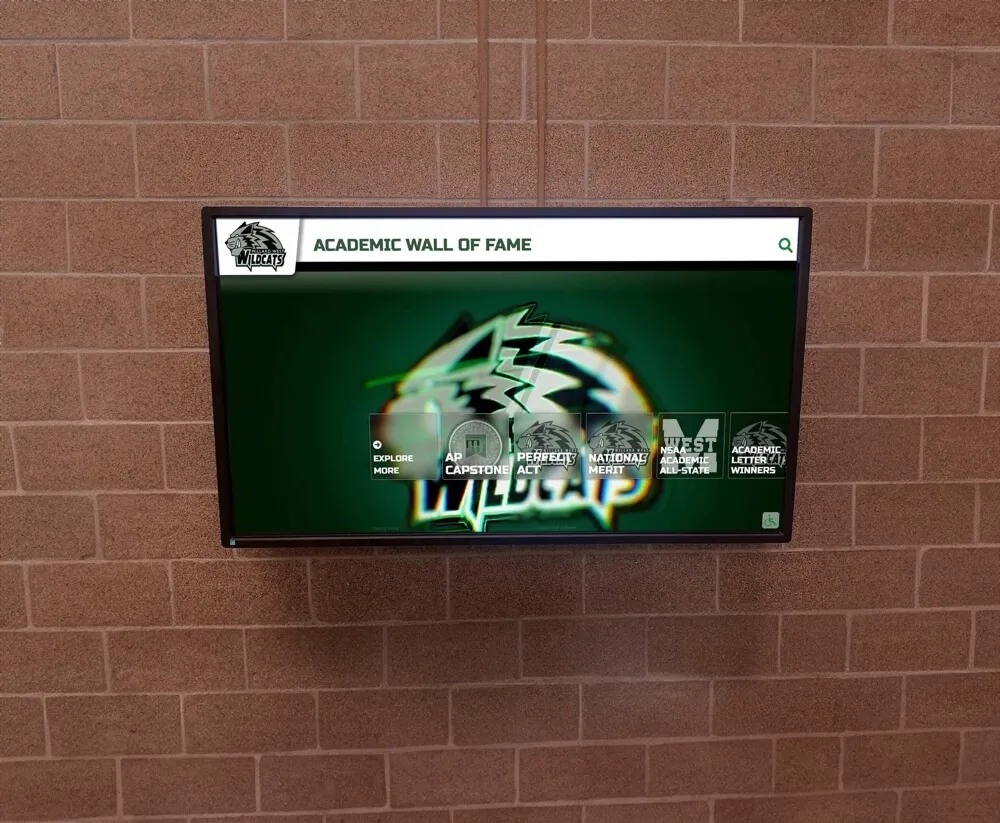Key Takeaways
Discover how interactive displays celebrate perfect ACT score history at your school. Learn about the rarity of 36 scores, rising trends, and modern recognition solutions that inspire academic excellence.
Understanding Perfect ACT Scores and Their Significance
The ACT (American College Testing) examination represents one of the two primary standardized tests used for college admissions in the United States. With scores ranging from 1 to 36 based on performance across four subject areas—English, Math, Reading, and Science—the composite score provides colleges with standardized academic performance data for admissions decisions.
The Rarity of Achieving a Perfect 36
A perfect composite ACT score of 36 requires exceptional performance across all four subject sections, demanding not just strong knowledge but also perfect or near-perfect execution under timed testing conditions. According to recent ACT data, only approximately 0.22% to 0.33% of all test-takers achieve this perfect score annually.
To put this rarity in perspective, a score of 35—just one point below perfect—is achieved by roughly 0.62% of test-takers, meaning students who score 36 represent an even more exclusive group demonstrating truly exceptional academic preparation and performance.
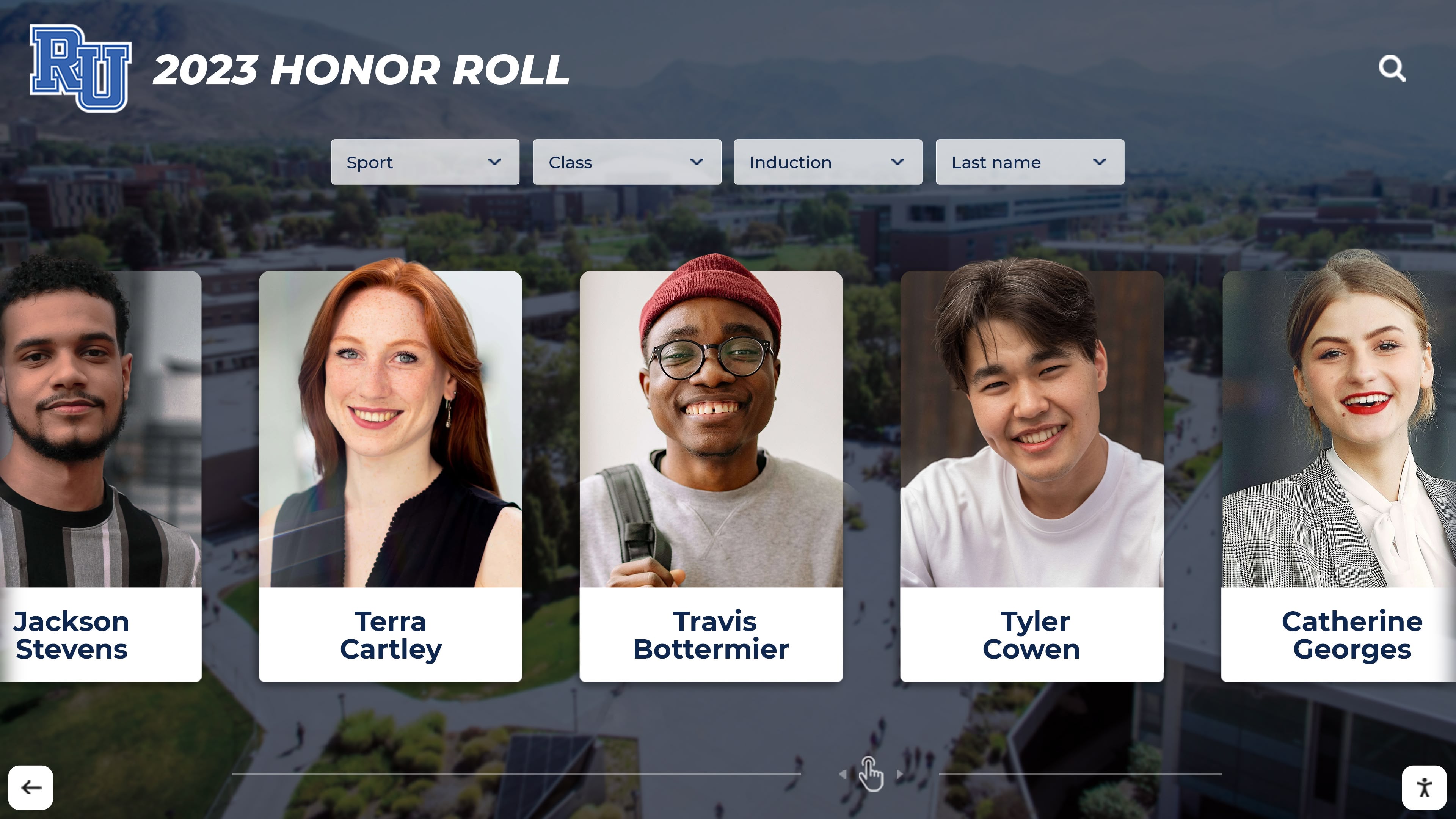
In 2020, approximately 5,579 students scored a perfect 36 out of over 1.6 million test-takers. While this represents an increase from previous decades, the achievement remains extraordinarily uncommon and deserving of significant recognition that validates years of academic dedication.
The Dramatic Rise in Perfect Scores Over Two Decades
One of the most fascinating trends in standardized testing involves the substantial increase in perfect ACT scores over the past twenty years. In 2001, only 89 students nationwide achieved perfect scores. By 2013, that number had crossed into four digits with 1,162 perfect scores. The trend continued upward, reaching 3,741 perfect scores in 2018.
This represents a dramatic shift: there were 9 times as many students who received a score of 36 in 2018 compared to 2008, and an astounding 53 times as many perfect scores compared to 1998. Even after adjusting for the rising number of people taking the ACT, perfect scores were 10 times more common in 2018 than in 2001.
Several factors may contribute to this trend including improved test preparation resources and widespread availability of online practice materials, increased understanding of test formats and strategies among students and educators, broader access to advanced coursework preparing students for college-level material, and potentially changes in test difficulty or scoring methodologies over time.
Regardless of the underlying causes, this trend means that high schools—particularly those serving high-achieving student populations—increasingly have multiple students per year earning perfect scores, creating both celebration opportunities and recognition challenges that traditional approaches struggle to address effectively.
Why Perfect ACT Score Recognition Matters
Celebrating perfect ACT scores serves multiple important purposes beyond simply acknowledging individual achievement.
Validation of Academic Excellence
Students who achieve perfect ACT scores typically invest years developing the knowledge, skills, and test-taking strategies required for this level of performance. Recognition validates this sustained effort and dedication, demonstrating that extraordinary academic achievement receives appropriate institutional acknowledgment rather than passing unnoticed beyond brief mention in morning announcements.
Inspiration for Current and Future Students
When schools prominently showcase perfect ACT achievers, they create visible role models for younger students beginning their own test preparation journeys. Seeing that recent graduates—students who may have been teammates, classmates, or neighbors—achieved perfect scores makes the accomplishment feel attainable rather than impossibly distant.
Schools implementing comprehensive student achievement recognition report that visible academic excellence displays motivate increased student effort, test preparation participation, and academic aspiration as students see concrete examples of what excellence looks like in their school community.

Demonstration of Program Quality
For schools, perfect ACT scores provide tangible evidence of academic program effectiveness and college preparation quality. When prospective families research school options, comprehensive academic recognition including standardized testing achievements demonstrates institutional commitment to excellence and track record of preparing students for competitive college admissions.
Building Institutional Pride and Tradition
Schools that consistently produce perfect ACT scorers build traditions of academic excellence that become part of institutional identity. This pride strengthens school culture, connects alumni across generations, and creates positive competitive motivation where academic achievement receives celebration equal to athletic accomplishments.
The Evolution of Perfect ACT Score Recognition
As perfect ACT scores have become more common, schools have experimented with various recognition approaches—each with distinct advantages and limitations that impact long-term effectiveness.
Traditional Recognition Methods and Their Constraints
Bulletin Board Displays
Many schools initially recognize perfect ACT scorers through bulletin board displays in counseling offices or main hallways. While these provide immediate visibility, they face inherent limitations including temporary nature requiring removal each semester or year to make room for new content, minimal information capacity beyond student photos and names, physical deterioration as paper fades and pins pull through materials, and limited accessibility to only those who physically visit school during business hours.
Bulletin board recognition typically disappears within months, meaning that students who achieve perfect scores early in the school year receive substantially longer visibility than those scoring late in the year—an arbitrary inequality that diminishes recognition value.
School Website Announcements
Website news sections provide another common recognition avenue, offering advantages like immediate publication and broader accessibility beyond campus visitors. However, news-based recognition faces its own challenges: content quickly scrolls off homepage as new announcements appear, achievement information becomes buried in archives difficult to find without specific searching, and format typically provides minimal context or storytelling beyond basic facts.
Within weeks or months, website recognition becomes effectively invisible as newer content takes prominence, leaving perfect score achievers without sustained recognition presence.
Physical Plaques and Trophy Recognition
Some schools include perfect ACT scorers on academic achievement plaque walls alongside other honors. While this provides more permanent recognition than bulletin boards or websites, traditional plaques face fundamental constraints including finite wall space that eventually fills completely, expensive per-student costs ranging from $75-$300 per plaque, installation delays requiring weeks between achievement and display, and limited information capacity restricting content to basic details like names and years.
Schools with decades of perfect score achievement eventually exhaust plaque wall capacity, forcing difficult decisions about whether to stop recognizing new achievers, remove older plaques, or invest in expensive wall expansions.
The Space Limitation Challenge
As perfect ACT scores have increased from rare exceptions to recurring achievements—particularly at high-performing schools where multiple students per year reach this milestone—space constraints become increasingly problematic.
A school that has produced perfect ACT scorers for just 15 years, averaging three students annually, accumulates 45 achievements requiring recognition. Traditional plaque systems accommodate perhaps 50-100 total entries across all academic honors before visual clutter and physical space limitations make additional plaques impractical.
This capacity constraint forces schools to choose between comprehensive recognition celebrating all perfect scorers throughout history or focusing only on recent achievements while allowing older accomplishments to fade from institutional memory. Neither option satisfies the dual objectives of honoring every achievement appropriately while inspiring current students through complete historical context.
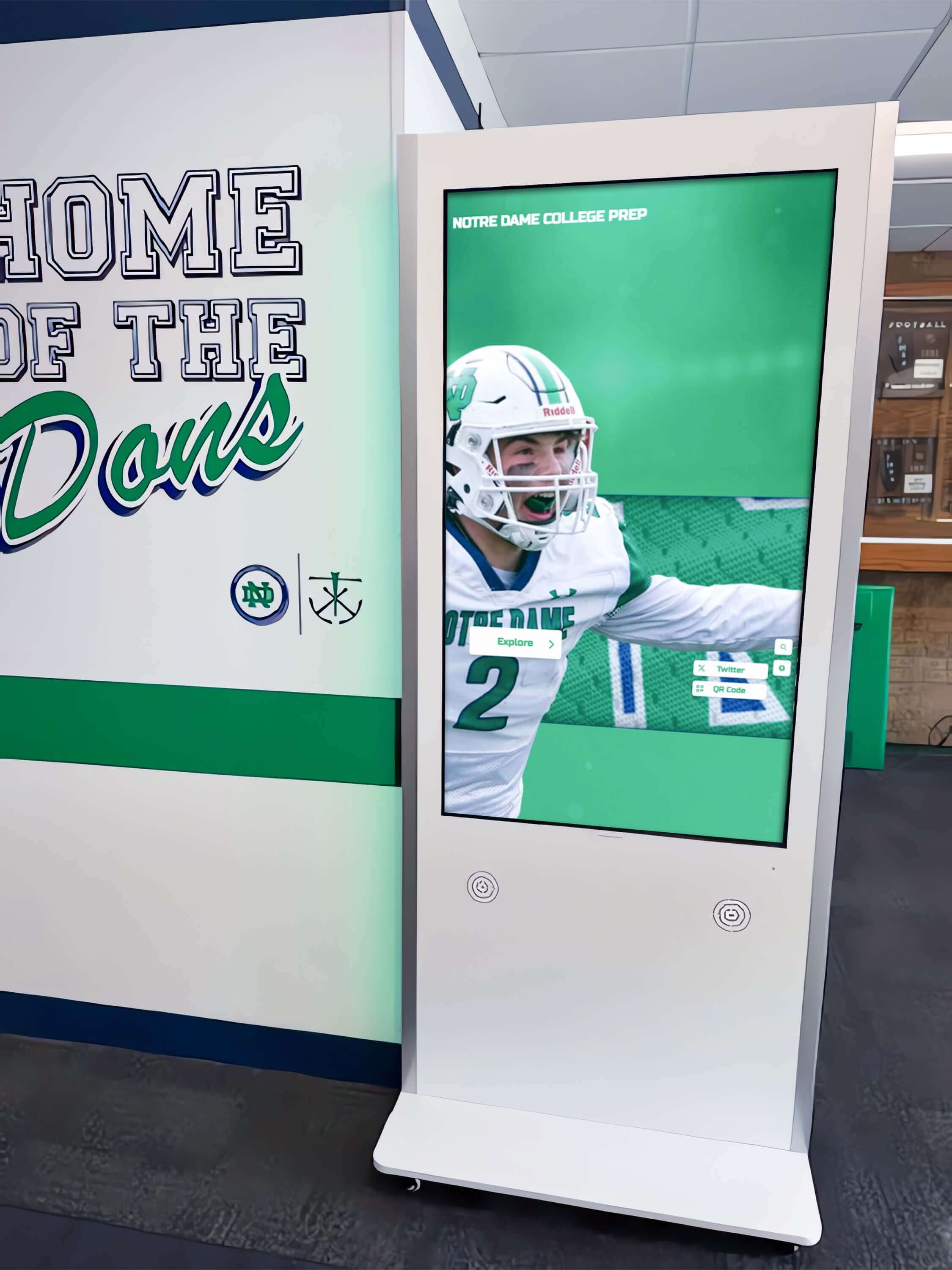
Modern Interactive Display Solutions for Academic Recognition
Digital recognition technology addresses traditional limitations while introducing capabilities that fundamentally transform how schools celebrate perfect ACT scores and other academic achievements.
Unlimited Recognition Capacity Without Space Constraints
Interactive touchscreen displays eliminate the physical space limitations that constrain traditional recognition approaches. A single 55-inch display can showcase comprehensive profiles for hundreds or even thousands of academic achievements—capacity that would require dozens of linear feet of plaque wall space to accommodate physically.
This unlimited capacity enables schools to recognize complete perfect ACT score history from the first achievement forward, honor all perfect scorers equally regardless of when achievements occurred, include additional academic recognitions alongside ACT scores for comprehensive celebration, and accommodate future achievements indefinitely without capacity concerns forcing difficult choices about whom to recognize.
Solutions like digital recognition systems provide purpose-built platforms specifically designed for academic recognition rather than generic digital signage requiring extensive customization to serve educational needs effectively.
Rich Multimedia Storytelling Beyond Names and Dates
Traditional plaques convey minimal information constrained by physical engraving space. Digital recognition enables comprehensive storytelling through high-resolution student photographs capturing achievement moments, complete academic profiles including GPA, class rank, and other achievements, college destination information and scholarship details showing post-secondary success, test preparation strategies and advice for current students preparing for their own ACT exams, video interviews or testimonials where students share their preparation experiences, and historical context about achievement significance and comparative rarity.
This multimedia depth transforms recognition from simple acknowledgment into compelling experiences that emotionally engage audiences and create lasting impressions about what academic excellence means in your school community.
Schools implementing comprehensive academic recognition programs create unified institutional pride while honoring diverse accomplishments across all academic domains from standardized testing to subject-specific competitions.
Interactive Exploration and Searchable Discovery
Static plaque walls force predetermined viewing sequences based on physical arrangement. Digital systems provide sophisticated exploration capabilities enabling students, families, and visitors to search by student name, graduation year, or achievement type, filter to specific time periods to explore historical trends, browse alphabetically or chronologically based on preference, view featured content highlighting recent achievements, explore related accomplishments from the same students, and compare achievement patterns across different decades or eras.
These capabilities ensure all achievements remain discoverable regardless of when they occurred, eliminating the “out of sight, out of mind” problem affecting older plaques relegated to less prominent positions on crowded walls or removed entirely due to space constraints.
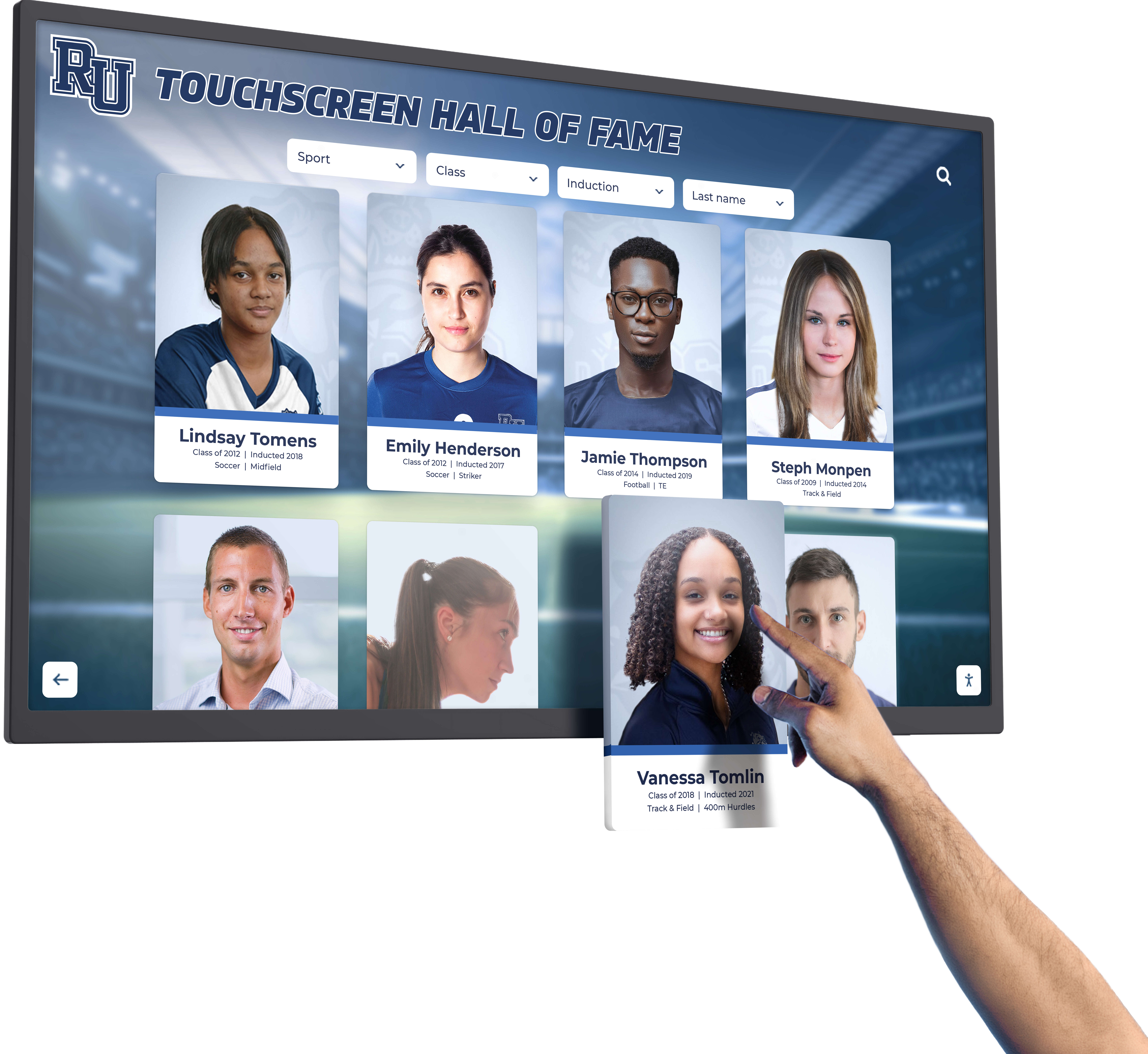
Instant Updates Celebrating Achievement When It Matters
Traditional plaque updates require ordering custom engraving, scheduling installation appointments, waiting 2-4 weeks for production and mounting, and paying per-plaque costs for each new addition. This timeline means students earning perfect scores often don’t see recognition appear for months after their achievement.
Digital systems enable immediate updates through cloud-based content management accessible from any internet-connected device. When a student achieves a perfect ACT score, recognition can appear within hours or days rather than months—celebrating achievement while excitement remains high rather than after the accomplishment becomes distant memory.
This immediacy transforms recognition from historical documentation into living celebration directly connected to current students and their ongoing preparation efforts.
Remote Accessibility Extending Recognition Beyond Campus
Physical displays reach only people who physically visit school facilities during hours when buildings are accessible. Digital recognition extends access globally through web-based viewing from any internet-connected device, mobile optimization for smartphone and tablet access, social media sharing extending visibility beyond school boundaries, embedded integration in school websites and college counseling pages, and alumni portals enabling remote exploration by graduates decades after leaving campus.
A perfect ACT scorer from 2010 can now share their digital recognition with children or grandchildren living across the country. Current students preparing for the ACT can explore role models from previous classes. Prospective families researching school academic quality can view comprehensive perfect score history demonstrating program excellence.
This extended accessibility transforms recognition from limited-audience displays into engagement platforms strengthening connections with distributed stakeholders while multiplying the motivational impact beyond those who happen to encounter physical displays during campus visits.
Creating Comprehensive Perfect ACT Score Recognition Programs
Successfully implementing perfect ACT score recognition requires systematic planning addressing content, technology, integration with broader academic recognition, and sustainable operations that maintain programs beyond initial enthusiasm.
Content Development and Information Gathering
Comprehensive digital recognition begins with collecting information about perfect ACT scorers across program history—a process that may prove surprisingly challenging for schools without systematic achievement documentation.
Historical Research Process
Many schools discover that complete records of perfect ACT scores don’t exist in organized formats, requiring research through yearbook reviews documenting college-bound students and honors, counseling office records containing standardized test score histories, school newspaper archives capturing contemporary achievement coverage, administrator and counselor institutional memory, college acceptance announcements often mentioning top test scores, and direct outreach to alumni asking them to self-report achievements.
Create systematic inventory documenting student names and graduation years, specific ACT scores and achievement dates, available photographs from testing day or recognition events, college destinations and scholarship information when known, current professions and post-graduation paths for alumni context, and any available quotes, advice, or testimonials from achieving students.
This research phase commonly takes 2-4 months for comprehensive programs depending on available records and historical depth. Schools with strong record-keeping complete research more quickly, while those with limited documentation may need extended timelines and alumni outreach efforts.
Content Standards and Consistency
Establish guidelines ensuring professional, consistent results across all achievement profiles including minimum required information for each student, optional enhanced content when available such as test preparation strategies, photography standards and resolution requirements, naming conventions and formatting rules, and verification procedures ensuring accuracy before publication.
Consistent standards ensure digital recognition maintains professional quality that appropriately honors academic excellence while facilitating effective searching and filtering that helps users find relevant content quickly.
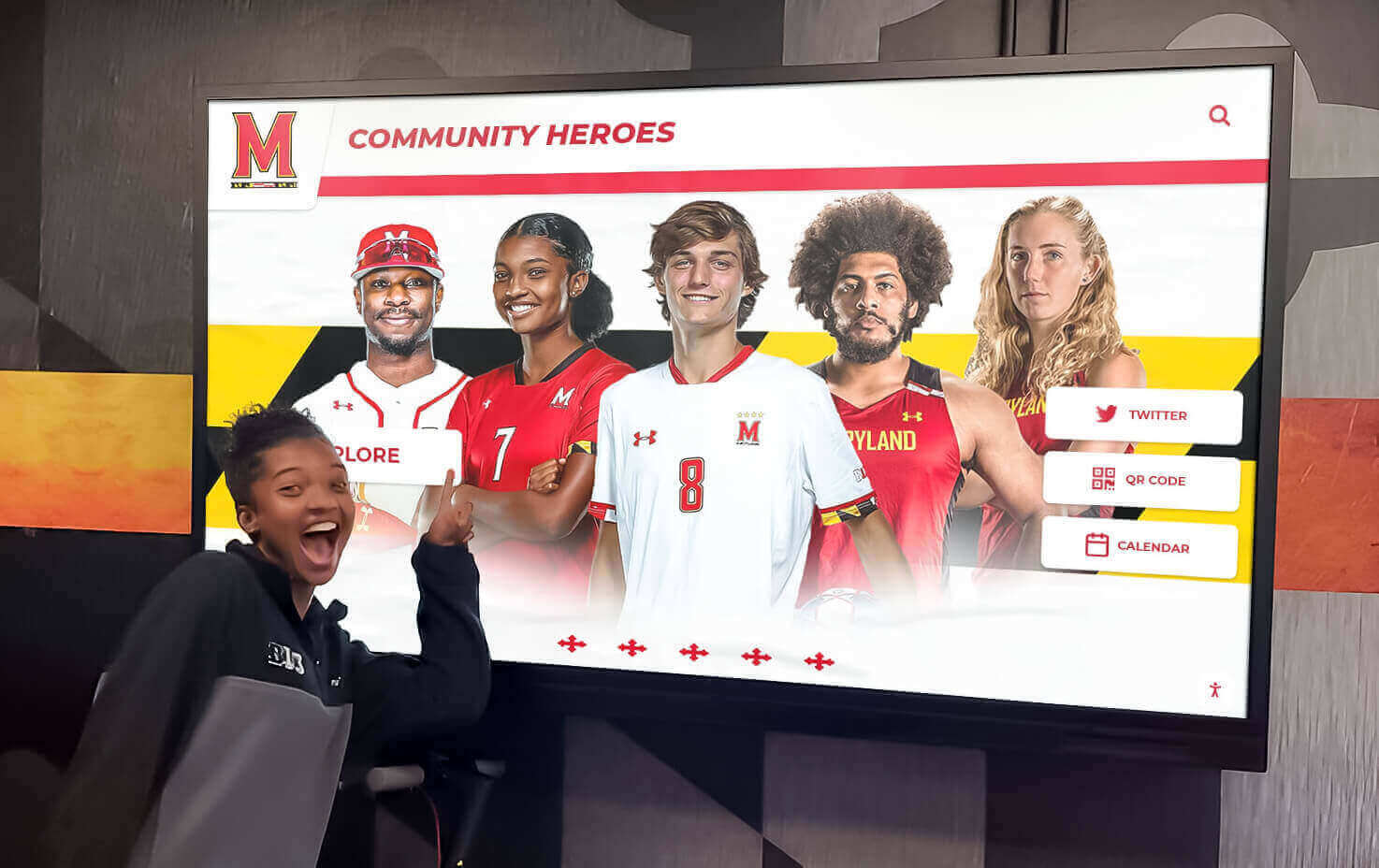
Integration with Comprehensive Academic Recognition
Perfect ACT scores rarely represent students’ only notable achievements. Most effective implementations connect perfect score recognition to comprehensive academic celebration including other standardized testing achievements like National Merit status, AP Scholar designations with scores on advanced placement exams, academic competition success in science olympiad, math contests, or debate tournaments, honor society memberships and leadership positions, scholarship recipients and college acceptances, and valedictorian or salutatorian recognition.
Schools implementing integrated recognition create unified academic celebration rather than fragmenting achievements across disconnected displays, helping students understand that academic excellence encompasses many forms and that sustained high achievement across multiple dimensions receives appropriate comprehensive recognition.
Platform Selection and Technical Implementation
Choose digital recognition platforms based on essential capabilities and organizational needs rather than making decisions solely on initial purchase price.
Critical Platform Features
Evaluate solutions based on intuitive content management requiring no technical expertise from staff, appropriate categorization for academic achievement organization, photo and video integration supporting multimedia storytelling, powerful search and filtering functionality, mobile-responsive web accessibility extending reach beyond physical displays, appropriate security and access controls protecting student information, reliable technical support and training resources, and analytics tracking engagement patterns and popular content.
Platforms specifically designed for educational recognition like Rocket Alumni Solutions provide purpose-built features that general digital signage systems lack, with interfaces optimized for school administrative workflows and educational recognition requirements.
Hardware Considerations
Digital display hardware decisions impact visibility, engagement, and long-term satisfaction including display size appropriate for viewing distance and location traffic (typically 43-65 inches for academic recognition areas), commercial-grade touchscreens rated for high-traffic public use, installation options including wall mounting or freestanding kiosks, placement in high-visibility locations like main hallways or college counseling areas, and adequate power and network connectivity infrastructure.
Professional installation ensures proper mounting, clean aesthetics, and reliable operation. Many providers include installation services with platform subscriptions, simplifying implementation logistics.
Budget Planning and Long-Term Value Analysis
Understanding comprehensive costs enables realistic planning and stakeholder buy-in for digital recognition investments that deliver sustained value across decades of use.
Initial Implementation Investment
Typical startup costs include commercial touchscreen display with mounting hardware ($3,500-$7,000), content management platform setup and licensing ($1,500-$4,000), content development and historical research ($1,500-$5,000), professional installation and configuration ($800-$2,000), and staff training and change management ($400-$1,200). Total initial investment commonly ranges from $7,700-$19,200 for standard implementations.
Ongoing Operational Costs
Annual recurring expenses include software platform subscription and support ($1,000-$3,500), content updates and management (staff time), technical support when issues arise ($300-$1,000), and hardware warranty or replacement reserves ($200-$600). Total annual costs typically range from $1,500-$5,100.
Comparative Value Analysis
Traditional recognition approaches appear less expensive initially but accumulate costs including new plaques for each achievement ($75-$300 per student), mounting and installation labor ($40-$100 per plaque), periodic wall expansions when capacity exhausts, regular maintenance and cleaning, and eventual replacement when materials deteriorate.
For schools recognizing 8-15 perfect ACT scorers annually, digital systems typically achieve cost parity within 5-8 years while providing dramatically superior recognition capabilities throughout their 10-15 year operational lifespans, resulting in substantially better long-term value even when initial costs run higher than traditional alternatives.
Highlighting Notable Perfect ACT Score Trends and Stories
The history of perfect ACT scores provides fascinating insights into academic achievement trends and creates compelling content for recognition displays that contextualize individual achievements within broader patterns.
Schools with Exceptional Perfect Score Records
Several high schools have gained national attention for producing remarkable numbers of perfect ACT scorers, demonstrating what comprehensive college preparation programs can achieve when resources, instruction, and student motivation align effectively.
Whitney Young High School in Chicago celebrated 23 students achieving perfect ACT scores in 2024-2025, representing what school leadership called “one of those rare, extraordinary moments in a school’s history.” The principal emphasized they were able to “pause and celebrate academic greatness” for each of these exceptional students.
Walter Payton College Preparatory High School, also in Chicago, reported 40 students scoring 36 on the ACT, while Lane Tech College Prep had 24 perfect scores during the same academic year. More than 125 Chicago Public Schools students overall achieved perfect scores, demonstrating the concentration of academic excellence possible within strong urban school systems.
Williamson County Schools in Tennessee celebrated more than 30 students earning perfect composite scores, with schools like Centennial High School, Brentwood High School, and Independence High School all contributing multiple perfect scorers to the district total.
These examples demonstrate that perfect ACT scores, while individually rare, can become institutional traditions when schools systematically support academic excellence through rigorous curriculum, effective test preparation resources, and cultures that celebrate intellectual achievement alongside athletic and artistic accomplishments.
Recognition Events and Celebrations
Schools and universities have developed creative approaches to celebrating perfect ACT scores beyond traditional static displays, demonstrating the importance institutions place on this level of academic achievement.
The University of Nebraska System partnered with Millard Public Schools to formally recognize 10 students who achieved perfect scores through a special event, demonstrating how universities and feeder school districts can collaborate to honor exceptional academic preparation that benefits both institutions.
Many schools now hold recognition ceremonies specifically for perfect ACT scorers, often timed to coincide with other academic honors events like National Honor Society inductions or scholarship award presentations. These ceremonies provide personal acknowledgment moments that complement permanent recognition displays, creating memorable experiences for students and families while building institutional traditions around academic excellence.
Some schools integrate perfect ACT score announcements into school assemblies, graduation ceremonies, or end-of-year academic awards programs, ensuring that perfect scores receive public recognition before entire school communities rather than acknowledgment limited to those who happen to encounter static displays.
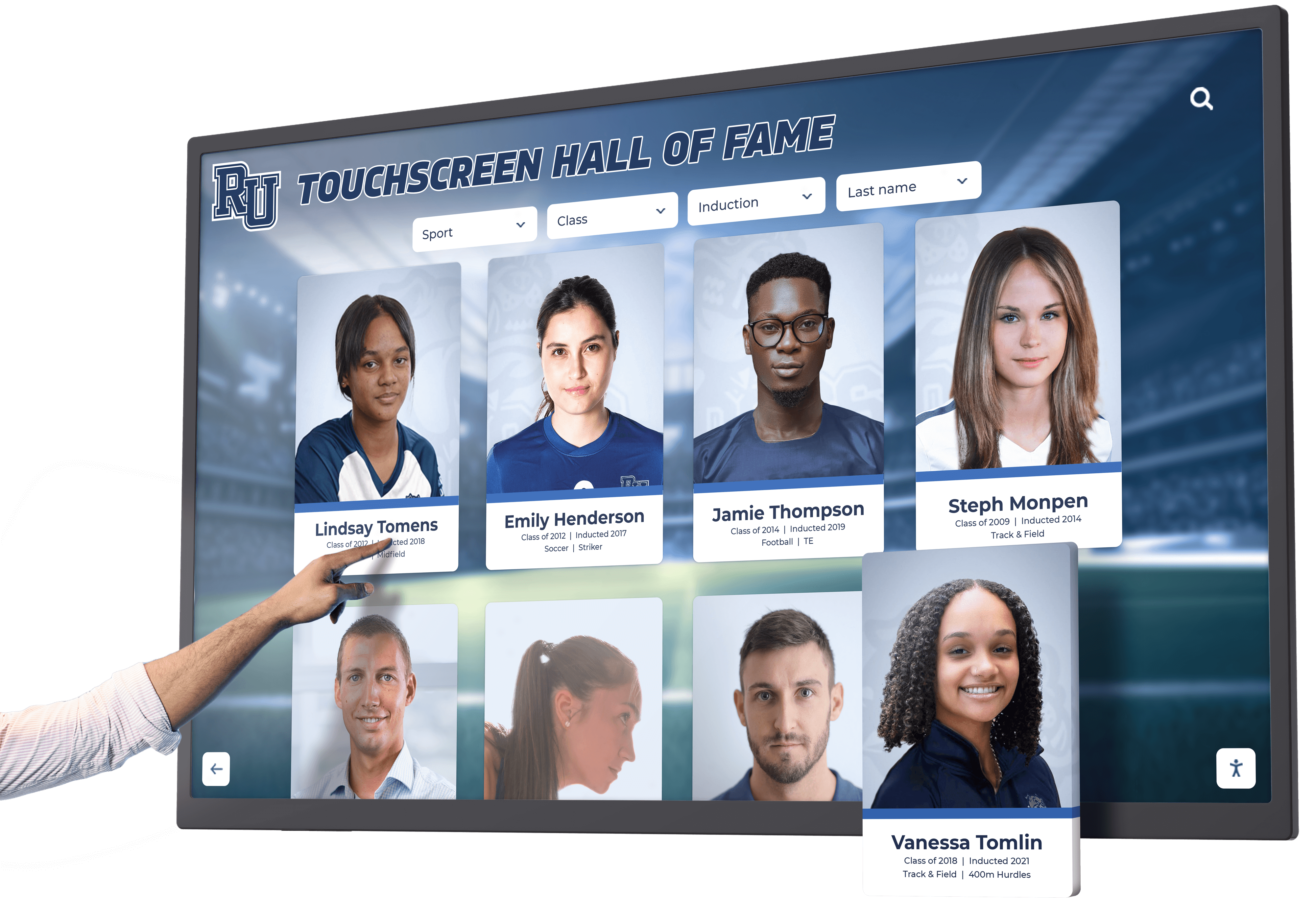
Best Practices for Perfect ACT Score Recognition Programs
Technology alone doesn’t guarantee successful recognition programs. Strategic implementation approaches amplify benefits and ensure long-term value that justifies initial investment while creating sustained motivational impact.
Create Compelling Achievement Profiles
Transform basic name listings into meaningful recognition that celebrates complete student accomplishments through detailed biographical information beyond just test scores, comprehensive academic achievements including GPA, class rank, and honors, high-quality photographs from school events or achievement celebrations, test preparation strategies and advice for current students, college destinations and scholarship information showing achievement outcomes, brief narratives explaining what made their preparation effective, and post-graduation updates for alumni showing career paths and continued success.
Profiles averaging 150-250 words with 2-3 photos provide sufficient depth without overwhelming viewers, while featured achievers can receive expanded coverage including video testimonials and extended preparation advice that helps current students learn from those who achieved perfect scores.
Promote Recognition Actively to Maximize Impact
Even exceptional displays require promotion to reach their potential impact through launch events creating awareness and excitement about new recognition capabilities, social media campaigns showcasing featured perfect scorers and their advice, integration with college counseling activities and test preparation programs, alumni communications highlighting web accessibility for graduates, student orientation including display demonstrations for incoming students, and media coverage generating broader community visibility and institutional pride.
High-profile launches communicate that schools take academic recognition seriously while creating initial engagement momentum supporting sustained program success beyond the novelty period following implementation.
Leverage Recognition for Current Student Motivation
The most effective perfect ACT score recognition programs don’t just honor past achievement—they actively inspire current students through featured advice sections where perfect scorers share preparation strategies, timeline displays showing when past achievers took the test and how they prepared, comparison tools allowing students to see improvement patterns across multiple test attempts, resource links connecting recognition to school test preparation programs, and goal-setting features encouraging students to pursue perfect scores themselves.
By connecting historical achievement to current student preparation, recognition becomes more than passive commemoration—it transforms into active motivation that directly supports improved testing outcomes for current students beginning their own ACT preparation journeys.
Measure Engagement and Demonstrate Recognition Value
Effective programs evaluate performance systematically through usage analytics including total interactions with perfect ACT score content, popular profiles indicating which achievers resonate most strongly, search patterns revealing how users discover content, time-of-year usage showing when recognition receives most attention (likely increasing before test dates), and social sharing frequency extending recognition reach.
Qualitative feedback from perfect scorer satisfaction with recognition approach, current student reports about how recognition influences motivation, family appreciation for comprehensive celebration, and college counselor observations about student engagement with content validates quantitative metrics while informing ongoing improvements based on actual user experience rather than assumptions about what might work effectively.
Conclusion: Honoring Academic Excellence Through Modern Recognition
Perfect ACT scores represent extraordinary academic achievement that fewer than one in 300 students nationwide accomplish—milestones deserving recognition that matches their significance and rarity. As perfect scores have increased from rare exceptions to recurring achievements at many high schools, traditional recognition approaches face mounting challenges including space constraints limiting comprehensive historical recognition, update delays diminishing motivational impact, minimal information capacity restricting storytelling, and limited accessibility reducing engagement to campus visitors only.
Modern interactive display technology transforms perfect ACT score recognition from space-constrained static listings into engaging digital experiences that honor every achievement appropriately regardless of when it occurred. Unlimited capacity ensures recognition for all perfect scorers throughout institutional history rather than difficult choices about whom to acknowledge. Instant updates celebrate achievement while excitement remains high. Rich multimedia storytelling conveys complete student accomplishments beyond simple names and dates. Interactive exploration helps audiences discover achievements personally relevant to them. Remote accessibility extends recognition globally beyond campus visitors.
The most successful programs share common characteristics including comprehensive content celebrating complete academic journeys beyond just test scores, systematic processes ensuring sustainable management without overwhelming administrative burden, active promotion creating awareness and engagement with recognition content, strategic integration connecting perfect ACT scores to broader academic celebration, and ongoing optimization based on usage data and stakeholder feedback.
Whether schools produce their first perfect ACT scorer or celebrate dozens annually, whether budgets allow immediate comprehensive implementation or require phased approaches, digital recognition delivers measurable value through enhanced student motivation, preserved institutional history, strengthened academic identity, and deeper community connections centered on intellectual excellence.
Modern digital recognition solutions like those from Rocket Alumni Solutions enable schools to honor perfect ACT scores through intuitive platforms designed specifically for academic achievement celebration. These systems combine unlimited recognition capacity with simple content management, creating professional displays that inspire current students while preserving academic history for future generations who deserve to understand the traditions of excellence they inherit and extend through their own achievements.
Perfect ACT scores represent more than just impressive numbers on standardized tests—they demonstrate sustained academic dedication, mastery across multiple knowledge domains, and preparation for collegiate success. Recognition that honors these achievements appropriately validates student effort while inspiring the next generation of scholars to pursue similar excellence, knowing their accomplishments will receive lasting acknowledgment that celebrates their place in institutional history.
Visit Rocket Alumni Solutions to explore how digital recognition transforms perfect ACT score celebration from outdated bulletin boards and limited plaque walls into engaging interactive experiences that honor academic excellence while inspiring future achievement across generations of students pursuing intellectual growth and standardized testing success.
